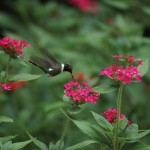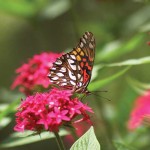Oliver Thornwhistle On—Night & Day
There is beauty and mystery in your garden around the clock
written by S.C. Johnson
Day Time
You have a pretty good idea of what is going on in your daytime garden, since every day you can watch the main attractions. They include hummingbirds and butterflies, lured by the modern trend of planting hummingbird and butterfly “friendly” plants and flowers. Hummingbirds aren’t all that picky, hitting on almost any flower, even if it is just a few feet from your nose at breakfast.
Butterflies definitely respond to a little coaxing. So-called butterfly weed, Asclepias tuberosa, is a weed to be sure, but a milkweed, one of the favorites for butterflies. I was recently shocked when a friend brought me a commercial pack of butterfly weed and it worked out to a U.S. nickel a seed. The real shock came when I found the same plant growing outside my gate—a weed indeed. A perennial, butterfly weed makes a great border, and the kids will delight at turning up the leaves and finding the tiny butterfly eggs that are often attached to the undersides. Wait until they cocoon, and take them inside to watch one of nature’s miracles unfold. Almost any salvia, or sage, there are 200 varieties, is a sure-fire butterfly magnet, too.
The Mexican sunflower, Totonia rotundifolia, is another butterfly destination. Although it is an annual, with some care in harvesting the seeds it can become perennial.
Night Time
But it is at night that the true magic of the garden is revealed. If the daytime, with orange and black monarch butterflies and ruby-throated hummingbirds, is modern Technicolor, a proud British invention from the 1930s, then the nighttime is an old-time black and white movie. Moths, many of them drab when compared to their showoff butterfly cousins, flit from flower to flower, performing the same essential pollination function. Preferred flowers, usually called this, that or the other alba from the Latin root word for white, are indeed white and the easiest for moths to find in the dark. Sit out on your patio or deck in partial or full moon light and enjoy the dance.
One of my favorites, and the seed is commercially available, is the appropriately named moonflower. Curled up tightly in daytime, this pure white flower unfurls to become Victoria Station for moths at night. I was thrilled during one of Guatemala’s seemingly frequent eclipses to see my moonflowers welcome the “night” by unrolling. Moonflowers can be shaped into bushes, which is a good idea since like any vine (they are a relative to the morning glory) they will otherwise soon take over.
Another, which I brought down from a roadside in Northern Mexico, is the chocolate vine, which, although again of course white, smells exactly like chocolate. But it spread so voraciously that I had to let it go.
There is a danger potentially lurking in your nighttime garden. The flor huele de noche tree, literally “flower, smells at night” is seductively covered with highly fragrant white blossoms that moths love. But it is actually a jessamyn tree and known to cause asthma and bronchial and breathing problems. Plant one for sure, but far from the windows.
Astute readers may notice that I have left out the firefly. But that’s because this fascinating natural LED rates its own treatment (May 2010 Revue).

